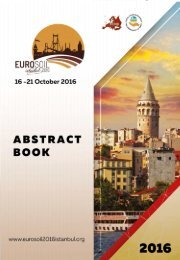You also want an ePaper? Increase the reach of your titles
YUMPU automatically turns print PDFs into web optimized ePapers that Google loves.
142 Agricultural and Natural Research & Reviews
2.5. Traditional foods
This grape cultivar, which is generally consumed as a table, is also used in human
nutrition in the form of products obtained by processing grape must in different
ways (vinegar, molasses, sausage, pulp, bastik, meatballs, etc.). Additionally, a
product called Saruç, which is a traditional product that is dried by hanging on
a rope and then offered for consumption after the walnuts are placed into the
grapes that are cut into two, has been made from the ‘Karaerik’ grape cultivar
since ancient times in the region. With its high nutritional content and a special
aroma, the product, which is in high demand in the region, can find buyers at a
very higher price. In studies on Saruç, its pH, ash content, total soluble solids
(TSS), dry matter, moisture, and skin color values and chemical properties (total
acidity, protein, N, P, K, Ca, Mg, S, Fe, Zn, Cu, Na) was detected. Based on the
results of the study, it was determined that 185 g of raisins were obtained from
one kg of fresh grapes, and 1 kg of Saruç consisted of 685 g of raisins and 315
g of walnuts. In addition, according to the results of the analysis, the pH, TSS,
protein, P, Ca, Cu values of the obtained Saruç were found to be 3.13, 5.77%,
7.48%, 225.20 mg, 59.40, Cu 0.66 mg, respectively (Kalkan et al., 2012). On
the other hand, though it is known that vinegar and molasses are made from this
grape cultivar in the region, studies on this subject have not been found in the
literature.
2.6. Improving the grape quality
In this context, the effects of two different organic biostimulants containing
mineral and organic compounds (seaweed-based) on the grape quality of
‘Karaerik’ grape cultivar were investigated by Köse & Gülyüz (1999) in
field conditions. Both mineral and organic compounds have been reported to
reduce TSSC and reducing sugars in the must and total dry matter of the berry.
Compared to the control, the effects of biostimulator applications decreased the
rate of fruit falling in all treatments and all of these applications showed similar
effects. In addition, while Proton application did not have an effect on the spilled
berry rate in the study, it was determined that Maxicrop applications other than
1250 mg kg -1 reduced the spilled berry rate (Köse & Güleryüz 1999). On the
other hand, three grapevine training systems (vertical shoot positioning-shaped,
Y-shaped and traditional Baran system) and three different (75, 100, and 125 cm)
trunk heights were compared for their effects on skin color, berry weight, cluster
weight (g), TA%, pH, TSS%, MI, organic acid, sugar, antioxidant activity
(FRAP) and vitamin C as well as total and individual phenolic compounds






